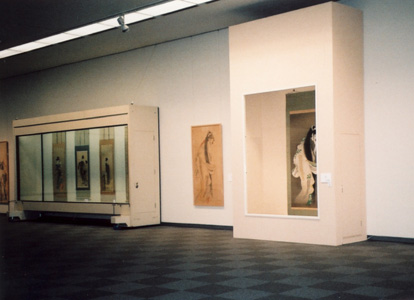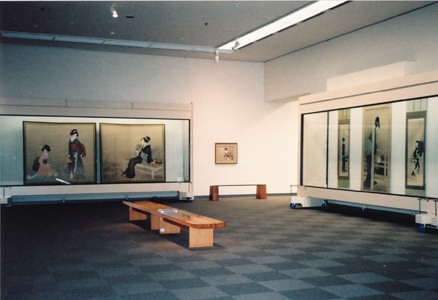UEMURA Shoen
Anniversary exhibition of the renewal opening
|
14 April - 23 May 2004 Hours: 9:30a.m.- 5:00 p.m. (9:30 a.m.- 20:00 p.m. on Fridays) Admission: |
THE ARTISTIC CAREER OF UEMURA SHOEN
|
Her Association with the Government-Sponsored ExhibitionsIn 1907, Shoen submitted the painting Long Night to the First Ministry of Education Art Exhibition. Other submissions to the ministry's annual exhibitions followed in subsequent years. About the same time, Shoen consciously began to work with a broad range of subjects. Drawing from her previous artistic training and her experience studying woodblock prints and older painting styles, she started pursuing new techniques and styles of composition. These efforts brought great critical acclaim. The painting An Arrangement of Flowers, which she submitted to the Ninth Ministry of Education Art Exhibition, is groundbreaking in terms of technique. To create the painting, Shoen drew a human face over the kinds of features that one would find on a mask of the no theater. This means of creating an image is shared with the work Soshi-arai Komachi (Ono no Komachi Washing Away Forged Poems), painted late in Shoen's life. In 1917, Shoen submitted the painting Flames to the Twelfth Ministry of Education Art Exhibition. The painting drew its inspiration from the no play Aoi no ue, which is in turn based on eleventh-century classic of Japanese literature, The Tale of Genji. The image shows the vengeful spirit of Miyasudokoro, the Rokujo Princess, who is jealous of Genji's wife. The theme of the painting is a rather unusual one for Shoen. At the time, there were many young artists who aspired to produce a new kind of nihonga and who painted images of beautiful women that seemed to exude an aura of decadence. Shoen, meanwhile, had dedicated herself to producing images of beautiful women. The fact that she shifted styles to produce Flames leads one to imagine that she was probably distressed over the direction that her own works were taking. For several years after showing Flames, Shoen did not submit any paintings to any government-sponsored exhibitions. She did not submit any work to the final few exhibitions sponsored by the Ministry of Education, and it was not until 1922 when again she showed her work in a government-sponsored exhibition. In 1922, Shoen returned to the art world by exhibiting the painting Yang Guifei at the Fourth Exhibition of the Imperial Academy of Fine Arts. (Yang Guifei was a beautiful woman who lived in Tang-dynasty China. According to legend, she was so beautiful that the emperor fell so madly in love with her that he allowed his country to fall into disarray.) Shoen's painting, which shows Yang Guifei after a bath, is ambitious in its scope and execution, and it shows that Shoen had fully recovered from her slump. |
The Perfection of Her ArtDuring her late fifties and sixties, Shoen produced many of the large works that are now considered her masterpieces, including Spring and Autumn (1930), Jo-no-mai (1936), and Soshi-arai Komachi (1937). Of the sixty years of her long career, one can rightfully point to this era as the height of her artistic abilities. During this time, she also had a number of big changes in her household that brought about significant changes her personal life. In 1927, her son and successor Shintaro (also known by his artistic pseudonym Uemura Shoko) got married, and in 1933, he fathered a child, Atsushi. Also in 1934, Shoen's mother, Nakako, passed away. The paintings Shoen produced during about this time are characterized by a strong feeling of presence and majesty. These effects are grounded in her use of light colors and colored surfaces, her use of negative space, her terse use of line, and her propensity to combine traditional subject matter with a modern humanist perspective. The paintings Jo-no-mai and Soshi-arai Komachi both draw their inspiration from the no theater. (The jo-no-mai is a dance performed in a no play, and Soshi-arai Komachi is the name of a no play about the Heian-period poetess Ono no Komachi.) Both paintings also place a large central figure against an empty background. In this way, these paintings might be seen as related to the 1918 painting Flames. Unlike Flames, however, these paintings show a more constrained use of expression and a greater emphasis on the bodily presence of the figures. The use of color is carefully planned so that the light surfaces of the clothes and other items stand out prominently against the empty background. If one takes these points into consideration, one can easily see that after painting Flames, Shoen began branching out into new territory. |
Her Final YearsAs of the 1930s, Shoen's position in the art world was relatively secure; however, even as a successful artist, she could not help reflecting the changing social circumstances of Japan in her work. New motifs appeared in her paintings about that time. The reason appears to be related to the overwhelming changes in Japanese society as the country moved down the path of militarization. Many of these works show working women who display a strong sense of vitality. One finds similar motifs in a number of works from the 1940 onward, including Twilight (1941), Clear Day (1941), and Late Autumn (1943). The main subject of these paintings are women engaged in daily chores, such as sewing and pasting fresh paper on sliding lattice doors (shoji). The women that appear in these paintings are all hard-working, and we see the sweat forming beads on their brows. These works show a keen observation for detail, a calm use of color, neat lines, and a skillful use of negative space. Because of this, there are some people who identify this period as another high point in Shoen's career. These paintings reflect an interest in contemporary society and humanity that is not usually seen in Shoen's work. In February 1945, Shoen was evacuated from Kyoto to the suburbs of Nara. In the postwar period, she became the first woman ever to receive the prestigious Order of Cultural Merit from the government; however, not long afterward, in August 1949, she passed away, putting an end to a long and prolific career. |
|
1st room 3rd room
|


